
About UsThe Numismatic Bibliomania Society is a non-profit organization promoting numismatic literature. For more information please see our web site at coinbooks.org SubscriptionsThose wishing to become new E-Sylum subscribers (or wishing to Unsubscribe) can go to the following web page link MembershipThere is a membership application available on the web site Membership Application To join, print the application and return it with your check to the address printed on the application. Membership is only $15 to addresses in the U.S., $20 for First Class mail, and $25 elsewhere. For those without web access, write to: David M. Sundman, Secretary/TreasurerNumismatic Bibliomania
Society AsylumFor Asylum mailing address changes and other membership questions, contact David at this email address: dsundman@LittletonCoin.com SubmissionsTo submit items for publication in The E-Sylum, just Reply to this message, or write to the Editor at this address: whomren@coinlibrary.com
BUY THE BOOK BEFORE THE COINYou won't regret it! |
- WAYNE'S WORDS: THE E-SYLUM MARCH 15, 2009
- NEW BOOK: NUMISMATIC FINDS OF THE AMERICAS BY JOHN KLEEBERG
- BOOK REVIEW: ABRAHAM LINCOLN: THE IMAGE OF HIS GREATNESS BY FRED REED
- REFERENCES ON WWI CITY AND STATE MILITARY SERVICE MEDALS
- SYMPOSIUM HONORS MEDALLIST MARCEL JOVINE
- ALAN WEINBERG ON THE 2009 PORTLAND ANA CONVENTION
- MORE ON WOODGRAIN COIN SURFACES
- MORE ON THE SPINEY FUBBADUCK
- QUERY: NEW ZEALAND AND AUSTRALIAN TOKEN REFERENCES SOUGHT
- LOCATION OF CIVIL WAR HUNTING PARTY VIGNETTE SCRIP ISSUER FOUND
- QUERY: NUMISMATIC TRANSLATION, INTERPRETATION AND ESTIMATION
- QUERY: AN UNUSUAL VICTORIA YOUNG HEAD PENNY BROCKAGE
- THOUGHTS ON HOWARD BERLIN'S PROPOSED NUMISMATIC MUSEUM GUIDEBOOK
- MORE NOTES ON ABRAHAM LINCOLN
- MAINE POLICE DEPARTMENT GIVING CHALLENGE COINS TO GOOD CITIZENS
- FIRM OFFERS FANTASY'S BASED ON SMITHSONIAN'S CHARLES BARBER PUERTO RICO SKETCH
- COIN COLLECTING AND SNOW DO NOT MIX
- IF THAT'S THE QUEEN, THEN I'M KAISER WILHELM
- FEATURED WEB PAGE: PUERTO RICO MONETARY HISTORY
WAYNE'S WORDS: THE E-SYLUM MARCH 15, 2009
 Among our recent subscribers are Jim Fields and Dick Schmachtenberg, courtesy of Ron Abler, Robin Sisler, Henry White, and Richard Freedland. Welcome aboard! We now have 1,221 subscribers.
Among our recent subscribers are Jim Fields and Dick Schmachtenberg, courtesy of Ron Abler, Robin Sisler, Henry White, and Richard Freedland. Welcome aboard! We now have 1,221 subscribers. This week we open with information on a new Numismatic Notes and Monographs book from the ANS and a review of Abraham Lincoln: The Image of His Greatness.
Topics this week run the gamut from references on city and state WWI medals, medallist Marcel Jovine, woodgrain surfaces, and Charles Barber's sketch of a proposed coin for Puerto Rico.
To learn about the secret message found inside Lincoln's watch, read on. Have a great week, everyone!
Wayne Homren
Numismatic Bibliomania Society
NEW BOOK: NUMISMATIC FINDS OF THE AMERICAS BY JOHN KLEEBERG
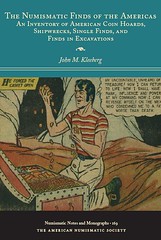 Numismatic Finds of the Americas: An Inventory of American Coin Hoards, Shipwrecks, Single Finds, and Finds in Excavations by John M. Kleeberg. The June 2009 release of Numismatic Finds of the Americas collects together for the first time the evidence for hoards, buried treasure and other finds of numismatic material from the Americas.
Numismatic Finds of the Americas: An Inventory of American Coin Hoards, Shipwrecks, Single Finds, and Finds in Excavations by John M. Kleeberg. The June 2009 release of Numismatic Finds of the Americas collects together for the first time the evidence for hoards, buried treasure and other finds of numismatic material from the Americas. An inventory enumerates approximately 900 coin finds, chiefly from the United States, but also from Canada and most other countries in the Americas. This is supplemented with a listing of 150 finds of American coins outside the Americas.
Each entry contains the find spot, date of discovery, date of deposit, detailed description of the contents, and a bibliography. The inventory exploits the numismatic, shipwreck, and archaeological literature, newspapers, and law reports of treasure trove cases more thoroughly than has ever been done before.
This volume is available at the pre-publication price of $65 for orders received before June 15, 2009 (plus shipping and tax for NY residents).
To order online or to download a pre-publication order form, visit: www.numismatics.org/Departments/BooksForPurchase
Kleeberg, John. Numismatic Finds of the Americas: An Inventory of American Coin Hoards, Shipwrecks, Single Finds, and Finds in Excavations. (Numismatic Notes and Monographs No. 169) New York:
American Numismatic Society. 2009.
ISBN 978-0-89722 -311-9
Hardback, Price US $125
BOOK REVIEW: ABRAHAM LINCOLN: THE IMAGE OF HIS GREATNESS BY FRED REED
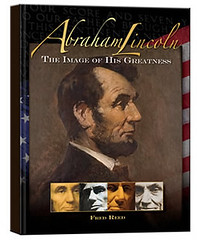 This book is misnamed. It is called Abraham Lincoln; The Image of His Greatness. It should be Images. There are a phenomenal 926 images in the book! It is a picture book without being a picture book (because of its useful adjacent text). On the other hand the word "Greatness" was well chosen. In addition to Lincoln the man, the same greatness could be said of the Lincoln book, and perhaps even the author himself, Fred "Lincoln" Reed, for compiling in one place such a galaxy of collectible Abe Lincoln items. Can you say "Lincolniana extravaganza"?
This book is misnamed. It is called Abraham Lincoln; The Image of His Greatness. It should be Images. There are a phenomenal 926 images in the book! It is a picture book without being a picture book (because of its useful adjacent text). On the other hand the word "Greatness" was well chosen. In addition to Lincoln the man, the same greatness could be said of the Lincoln book, and perhaps even the author himself, Fred "Lincoln" Reed, for compiling in one place such a galaxy of collectible Abe Lincoln items. Can you say "Lincolniana extravaganza"?The book is divided into four time periods. But don't look for this to coincide with the four period issues on the reverses of the 2009 Lincoln cents, or the four U.S. postage stamps, all issued this same Lincoln Bicentennial year. Those occupy Lincoln's lifetime.
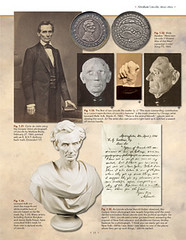
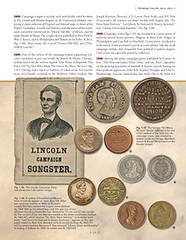
Fred Reed's periods divide the bicentennial's 200 years. Chapter 1 lists items issued during Abe's lifetime. Fred named all others with similar alliterative words for succeeding 50-year periods: Ideal, Idol and Icon. There is a fifth chapter that projects Lincolniana into the future, "Lincoln the Irrelevant?" (perhaps reflecting the political correctness that is eliminating the proper study of Lincoln in today's grade schools).
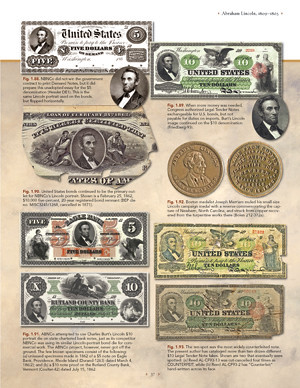 What is amazing is the vastness and variety of material portrayed among all the images. I did a count as best I could. There are more engravings than anything else. This includes 125 paper money images (that includes bonds, checks, certificates, receipts) plus 135 etchings (prints, CDVs, invitations, trade cards, mourning cards and such).
What is amazing is the vastness and variety of material portrayed among all the images. I did a count as best I could. There are more engravings than anything else. This includes 125 paper money images (that includes bonds, checks, certificates, receipts) plus 135 etchings (prints, CDVs, invitations, trade cards, mourning cards and such).For other numismatists, there are 46 coin images (U.S., foreign, patterns); 93 medals (with a couple plaques), 20 tokens. For the philatelist, 62 stamps, plus 32 post cards, covers and stationery items.
Photographs dominate throughout the book, 59 of them; there are 57 images from motion picture films and the stage. Nine paintings. Thirty-two images of sculpture, statues and busts (even one on my Lincoln bust -- thanks, Fred).
Magazine covers, 71, also include some title pages and advertisements; 12 news clippings. There are 64 drawings, including cartoons, 11 color lithographs (including those on cigar boxes).
Among other collectibles are 21 pinbacks and badges, 15 ferrotypes, 11 posters, 7 license plates, 4 cloth patches, 8 tickets, 22 labels, some autographed letters, plus one each: banner, button, pocket watch, album cover and one inlaid box. Doesn't that prove the variety?
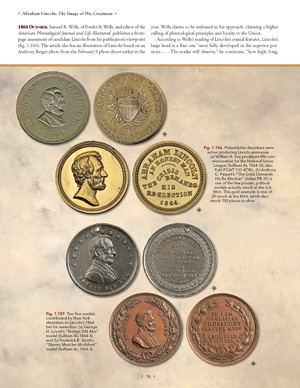 If this is considered a numismatic book it revels in "associated items" -- objects so closely related to the subject theme that they can be collected alongside the numismatic items just to amplify the topic. This book more than accomplishes that. It is a delight to the eyes and a shopping list to the serious collector. I can imagine any Lincoln collector turning each page and lusting to add the items to his collection illustrated in the book.
If this is considered a numismatic book it revels in "associated items" -- objects so closely related to the subject theme that they can be collected alongside the numismatic items just to amplify the topic. This book more than accomplishes that. It is a delight to the eyes and a shopping list to the serious collector. I can imagine any Lincoln collector turning each page and lusting to add the items to his collection illustrated in the book.Author Reed's own Lincoln collection served as the core of the items illustrated. To this he added showpieces gathered over a wide sweep of archives and fellow Lincoln aficionados' holdings. His acknowledgements run two pages, his photo credits are a coterie of individuals, organizations and U.S. Government offices.
Already collectors have nicknamed this work "Abebook." That might be quite the mnemonic coincidence. What a marketing master ploy par excellence. Every time you go on the internet to order a book from abebooks the website you will automatically think of Abebook, the product of Fred Reed's creative mind. Boy is that subliminal advertising!
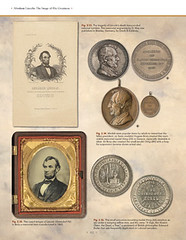 I couldn't find any errors in the book (certainly, there must be some!). I did find three items, however. I would have used a slightly different term in the description of an item illustrated. For example: the "medallion" of three presidents (Grant, Lincoln, Washington) page 139, should have been identified as an engraving, that is, an engraved print. No such engraved medallic item exists, which "medallion" leads one to believe.
I couldn't find any errors in the book (certainly, there must be some!). I did find three items, however. I would have used a slightly different term in the description of an item illustrated. For example: the "medallion" of three presidents (Grant, Lincoln, Washington) page 139, should have been identified as an engraving, that is, an engraved print. No such engraved medallic item exists, which "medallion" leads one to believe.Also the Lincoln portrait mounted on a wood board (figure 2.202, p 172) -- despite the legend underneath -- was made of "macerated currency" the preferred term in deference to "shredded currency" as so stated. This certainly was not Fred's fault. Most of these souvenir concoctions were produced by W.H. Abbott who dominated the custom which lasted from 1870-1940, by obtaining obsolete and worn U.S. paper currency in shredded form but could only be molded in a macerated form.
I would like to have had the 1860 "Rail Splitter of the West" token illustrated on page 17 credited to Darwin Ellis instead of just "Ellis" so it would not be confused with a handful of other Ellis engravers (including Jarvis, Darwin's son, who both worked for Scovill in Waterbury, and Mint artist Salathiel Ellis, no relation).
So this book is a delight for the eye -- for any American eye -- perhaps a "want list" for a collector, a source book for the Lincoln researcher, and a tribute to the American Ideal / Icon / Idol. It will be in use a great many times, I predict, before it could be resurrected in fifty or a hundred years for the next anniversary of our greatest president.
To order, visit the Whitman web site: Abraham Lincoln: The Image of His Greatness (www.whitmanbooks.com/Default.aspx?Page=81&ProductID=0794827047)
MOVING SALE
Numismatic literature for sale by collector
9,000 numismatic auction catalogs
1,000 numismatic books
Hundreds of different numismatic journals
Will provide very attractive pricing for sales of large lots.
Email Chris Hoelzle at choelzle@cox.net for lists.
REFERENCES ON WWI CITY AND STATE MILITARY SERVICE MEDALS
Joe Levine was the first to respond, offering these references:
- State, County, City and Organization Medals for World War I. Second Revised Edition by Richard L. Planck, 1991. Planchet Press Publication 48A. 124pp.
- Revised Comprehensive List of World War I Service Medals Issued By States, Counties, Cities & Towns by Louis W. Small, 1990, 84pp
Larry Dziubek contacted token and medal dealer Steve Tanenbaum. Steve was aware of the Small book and two others - a 3rd edition of Planck and a book by Dougles Bryce which covers state medals of all wars.
- State, County, City and Organization Medals for World War I by Richard L. Planck, 3rd Ed. 1995
- State Medals for War Service by Douglas W. Boyce, 1988
Harry Waterson submitted the Small reference as well. He
SYMPOSIUM HONORS MEDALLIST MARCEL JOVINE
The entire morning is devoted to the artist's numismatic creations. Three speakers extol the medallic work of this famed artist: Donald Scarinci tells of his numismatic works within the field of art, particularly Jovine's three Society of Medalists issues; Dick Johnson talks of his 95 coins and medals -- he did eight U.S. commemorative coins for example -- and medals for fourteen medallic series, among his total genre.
Jovine's most famous medal, the American Numismatic Society's 125th Anniversary Medal, considered the 20th century's most outstanding work, is the subject of a talk written by Alan Stahl. His speech will be presented by George Cuhaj, both of whom were on the committee in 1983 which chose the medal design. Each of the speakers will be available for questions, a chance to learn some rare insight to the collector lore of these popular collectibles.
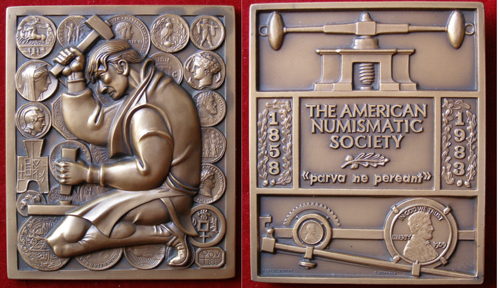
I wrote about the artist previously in E-Sylum on his death in 2003 (vol 6, no 4, art 9, January 26, 2003). Attend if you can. Many numismatists well be there in the morning.
To read Dick's 20003 E-Sylum article, see: MEDALIST MARCEL JOVINE DIED THIS WEEK (http://www.coinbooks.org/esylum_v06n04a09.html)
This year, colleagues and friends will gather to pay homage to innovative artist MARCEL JOVINE, one of America’s most noted industrial and fashion designers, a medallist, and a sculptor of figures and thoroughbred horses. Among his accomplishments were the design and creation of such toys as the Blessed Event doll for the Ideal Toy Company (which grossed $1 million in the first year), and lifelike plastic figures illustrating popular fairy tales including The Three Little Pigs, Little Red Riding Hood, Jack and the Beanstalk, and Hansel and Gretel.
He was also responsible for the design of nearly 200 medals and commemorative coins, sculptures of thoroughbred racehorses like 1978 Triple Crown winner Affirmed, as well as a bust and a figurine of Affirmed’s famous jockey, Steve Cauthen.
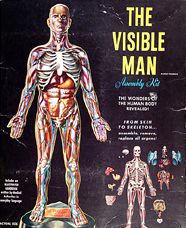 In the 1960s, working with medical doctors, he produced the anatomically accurate Visible Man and Visible Woman, with removable organs. Drawing on scientific studies, he fashioned his Cosmorama, a working model of a planetarium. Each of these was revolutionary in the world of educational toys.
In the 1960s, working with medical doctors, he produced the anatomically accurate Visible Man and Visible Woman, with removable organs. Drawing on scientific studies, he fashioned his Cosmorama, a working model of a planetarium. Each of these was revolutionary in the world of educational toys.Born Marcello Iovine in Naples, Italy, in 1921 (he Anglicized his name when he came to America), he was reared by a childless aunt and uncle after his mother’s death. He was an avid reader, had an active imagination, and took pleasure in sketching and modeling the characters in the stories he read.
At the end of the war, Marcel and Angela married and moved to New York, where Marcel got work designing window displays for boutiques. He also freelanced, creating industrial and fashion design campaigns for some of New York’s major advertising agencies and department stores.
With the money he received from the success of the Blessed Event doll, the Jovines bought a spacious Victorian home in Closter, New Jersey, where he established his studio.
During his lifetime Marcel Jovine received many honors and awards, among them the J. Sanford Saltus Medal for Medallic Art from the American Numismatic Society, the Medal of Honor from the National Sculpture Society, the Order of Saints Maurice and Lazarus by the Savoy Orders, an Italian philanthropic society that dates from the 12th century. He won six competitions from the US Mint for commemorative coin designs, including the last three Olympiads.
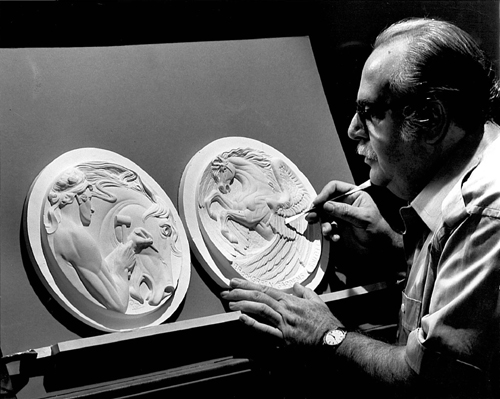
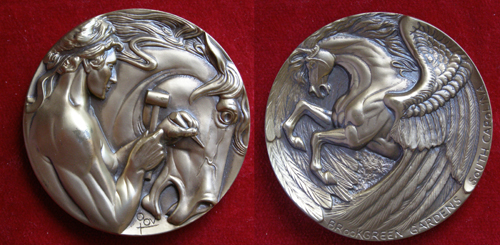
Marcel Jovine might be looked upon as a true Renaissance Man. When the technology to produce an idea did not exist, he called upon his engineering expertise and sketching and modeling talents to invent it.
To read the complete article, see: REMEMBERING MARCEL JOVINE (http://closterboro.com/Documents/SAMUEL%20DORSK
%20SYMPOSIUM,%202009%20PRESS%20RELEASE.pdf)
To read the complete Maine Antique Digest article, see: Only in America: the Story of Medalist Marcel Jovine (www.maineantiquedigest.com/medals/medalscolumn6.htm)
THE BOOK BAZARRE
ALAN WEINBERG ON THE 2009 PORTLAND ANA CONVENTION
Well, the show was fabulous - particularly in view of the modest expectations of many - with one of the heaviest public attendances I've ever seen at any ANA or for that matter any coin show. Hoards of people and not just lookie-loos, both on Friday and Saturday. A light drizzle in Portland helped the attendance and the bourse was a sell-out. You never saw so many people at a collectibles show - you had to turn sideways at times, return to a bourse table or exhibit later, due to crowds!
I roamed the bourse floor constantly and did not hear a single negative or mediocre comment. I did hear that the public was not spending big money and many were buying modern material or bullion-based coins. But I do know a beautiful and mark-free Wass Molitor $50 changed hands on the floor, going to a prominent collector/dealer for his own collection at $65K. I examined the coin- very atypical for this always bruised and marked up gold piece.
CoinRaritiesOnline (Dave Wnuck/John Agre) commented that they were quite surprised to have a very active show with numerous mid-range coins selling. I know that collector/dealer Bill McKivor of the Copper Corner had one heck of a show with the most fascinating and diverse atypical numismatic material I can recall seeing at a bourse table. His table was a constant "beehive" of real collectors with many buying sizable quantities of tokens and medals. John Kraljevich's table was at times so busy you couldn't find a space to squeeze into. Even with the economy in the doldrums, people were spending money and were clearly fascinated by the material on the bourse floor and in the exhibits. There was a significant juvenile attendance too.
The exhibits were quite impressive with Jerry Bobbe's single case exhibit of Spence Condors in Gem red and red-brown prooflike gems eliciting an involuntary "Oh my gosh!" as I walked up to it. Among the exhibits were a genuine 1804 dollar, a Gem Unc 1849 Oregon $10 gold, and two 1913 nickels. The Bureau of Engraving and Printing had a separate huge exhibit which was a hit with high attendance.
I examined at length the new 2009 hi-relief double-thick $20 (three of them) - just slabbed MS69 and 70. Ya know what?- there was a discernible difference in quality between the 69 and 70.
Dave Wnuck loaned me his just-released Whitman-published Dave Bowers Colonial Coin Encyclopedia. Real eye and mind "candy" although I thought it needed a sturdier binding given its projected heavy use by collectors. But a beautiful book and the numerous plates...!
The Oregon show staff that put together the show did a tremendous job all around. I know some of them and know them to be serious collectors. Bravo! I went home late Saturday, feeling fulfilled, happy and assured of a healthy continuance for our hobby, regardless of the economy. Years ago, I'd heard the Northwest had a solid core of collectors. Must be true.
MORE ON WOODGRAIN COIN SURFACES
Last week Dick Johnson wrote:His description of the phenomenon was right on target, but several readers noted that the term is not actually new.
Bob Neale writes:
Another reader writes:
Tom DeLorey writes:
David W. Lange, Research Director of Numismatic Guaranty Corporation (NGC) writes:
Here's an excerpt from Dave's article:
Examples having just light toning often display a pattern of tan or light brown streaks across obverse and reverse, the so-called “woodgrain” pattern. This resulted from impurities in the alloy or concentrations of pure copper that did not properly blend with the 5% tin and zinc added to it. When these less than perfect ingots were rolled into strip, from which blanks would later be punched, the concentrations were flattened and stretched into the patterns seen on the finished coins. Invisible when first struck, these flaws appeared only after the coin was exposed to atmospheric agents that caused the copper concentrations to tone more quickly than the properly mixed portions of the planchet.
Woodgrain toning is commonly seen on ‘S’ Mint cents through 1923-24, after which time it is encountered only occasionally.
Dave Bowers submitted this text from his 1996 book, A Buyer's and Enthusiast's Flying Eagle and Indian Cents.
Thus, an uncleaned, undipped Mint State red and brown bronze Indian cent of the 1864 to early 1870s years (and also 1908-S and 1909-S, but not the Philadelphia coins of those later years) is apt to have a “wood grain” effect to the toning, with streaks or “pellets” of brown toning, elongated, over yellowish-red mint red background, these streaks being oriented in a specific direction (caused by the distending of the minute alloy differences during the planchet strip rolling process).
The same wood grain effect is seen among certain dates of Mint State red and brown two-cent pieces. To my eye, this type of red and brown wood grain toning is very beautiful. Chris Pilliod seconded this sentiment, noting: “I agree and find these pieces very attractive, but the grading services apparently do not.” [
Jeff Hawk of Mercerville, NJ adds:
Jim Neiswinter submitted this image of a woodgrained Large Cent. He writes:
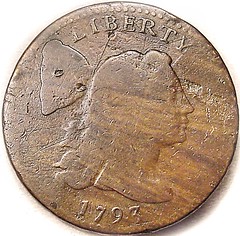 It's the discovery Sheldon-15 that I got out of the Van Cleave sale in 1986. There will be a display of the 1793 S-15 at next month's EAC convention. This is the second rarest collectable Sheldon variety with twelve known examples (two are in museums). Eight owners have agreed to bring their S-15s. The one owner that I have not been able to trace is the person who got the FR2 coin out of the Robbie Brown II sale in 1996. The buyer was Larry Briggs - a dealer from Ohio. I don't know whether he bought the coin for a customer or himself. I would like the owner to contact me at j_neiswinter@hotmail.com. to see if he would be interested in exhibiting his coin.
It's the discovery Sheldon-15 that I got out of the Van Cleave sale in 1986. There will be a display of the 1793 S-15 at next month's EAC convention. This is the second rarest collectable Sheldon variety with twelve known examples (two are in museums). Eight owners have agreed to bring their S-15s. The one owner that I have not been able to trace is the person who got the FR2 coin out of the Robbie Brown II sale in 1996. The buyer was Larry Briggs - a dealer from Ohio. I don't know whether he bought the coin for a customer or himself. I would like the owner to contact me at j_neiswinter@hotmail.com. to see if he would be interested in exhibiting his coin. Dennis Tucker writes:
Woodgrain toning goes back even farther than Large Cents. Byron Weston submitted this image of a woodgrained George II, 2nd Issue, farthing.

MORE ON THE SPINEY FUBBADUCK
Byron Weston writes:More recent copies of this "limited edition" can still be ordered from Bill McKivor, who has sort of become the American distributor of this tome.
QUERY: NEW ZEALAND AND AUSTRALIAN TOKEN REFERENCES SOUGHT
Ed Krivoniak of Pittsburgh is an old friend and longtime collector of New Zealand and Australian tokens. He writes:I would also be interested in any book or article on the Australian token makers Taylor, Stokes, or Stokes & Martin. Thanks in advance for any help you or the club can give.
THE BOOK BAZARRE
LOCATION OF CIVIL WAR HUNTING PARTY VIGNETTE SCRIP ISSUER FOUND
Walt Weigand writes:
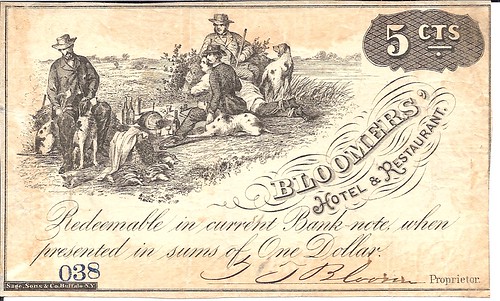
Wendell Wolka writes:
Kay O. Freeman writes:
I am not sure if Tooker Bloomer's middle initial "T" could stand for Thorn or Tucker. Internet genealogy a little murky; but Tooker's father seems to have married twice, both times to women whose last names, given above, start with "T."
I think the artist of the hunting party picnic vignette must have worked for John Sage & Sons in Buffalo. It seems to be original work. It does not seem to be based on A.B. Durand or Currier & Ives. Possibly, Erie County Historical or other Buffalo sources would know names of artists or engravers who worked for Sage.
John Sage was born 1807 in Massachusetts. His occupation is "music store" in 1860 Buffalo census. Internet search for his firm lists examples of sheet music - which seem to have been illustrated also. In 1870 Buffalo census, Sage and his son, John B. Sage, are listed as "lithographers". Another son, William S. Sage, is "store clerk"; but living in the household of a lithographer.
It is a very nice example of obsolete money.
QUERY: NUMISMATIC TRANSLATION, INTERPRETATION AND ESTIMATION
The medal owned by Joe's client was distinctively marked Medallic Art Co. Its only inscription was: OPUS AG II. I inquired of any other markings, perhaps an artist's signature, monogram or initials. None.
Translating and interpretation lettering on coins and medals is one of the most difficult chores in numismatics. We are hampered by languages foreign to us, and -- because of the limitation of space -- excessive abbreviation and shortening of words.
Translating can now be done on the internet. But don't expect to find coin and medal inscriptions. Darn. I have often used Google's translation service -- http://translate.google.com/?sssdmh=dm13.196359 -- but this never seems to work. It wants a specific language into another specific language. Often a C & M inscription is in Latin or an unknown language.
I tried the free Latin translation at http://www.translation-guide.com/free_online_translators.php?from=Latin&to=English. My OPUS AG II translated as DEEDS AG THESE.
I interpretation this could be HE DID THESE DEEDS. Or OPUS could also mean WORK. Taking it one step further I estimate (read: guess) this could have been a medal honoring the completion of some task, or a retirement medal after having worked for some unstated organization.
I also tried Yahoo's free translation, Babel Fish, at http://babelfish.yahoo.com/?sssdmh=dm13.196359 but this again wanted specific language to specific language.
A quick trip to my library (in the next room) I took down from the shelf a copy of James Mackay's Coin Facts & Feats. Its chapter "Inscriptions and Legends" is the best I have found on the subject. The author relates some coins from German States which had abbreviations as legends some 50 and 60 letters in length!
Does anyone reading this, perhaps with a 3,000 IQ who knows many languages, would like to start a web site that would record coin and medal inscriptions and who can provide their meaning in plain text English? You would earn the everlasting approbation of those of us who toil in the numismatic field and feel stumped by the mystical lettering. We could feed you a lot of these for your translation, interpretation and estimation.
QUERY: AN UNUSUAL VICTORIA YOUNG HEAD PENNY BROCKAGE
Bill Snyder writes: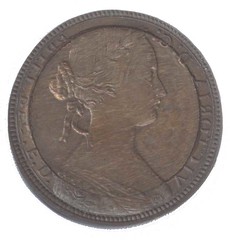 The mention of uniface Splashers, Galvanos and electrotypes in your last issue reminds me that I need help with this item. It was Spink's lot 2321 of an auction of Peck coins, February, 1972. It is uniface. Like a brockage, all devices are incuse and reversed.
The mention of uniface Splashers, Galvanos and electrotypes in your last issue reminds me that I need help with this item. It was Spink's lot 2321 of an auction of Peck coins, February, 1972. It is uniface. Like a brockage, all devices are incuse and reversed. Most of the bust is within a ring, and the metal color inside that ring is bright, almost brassy (whereas metal outside the circle appears to be copper. (The ring does not seem to have been a legend-centering aid, as it drives right through the "D.G."). The piece weighs 145.2 grains (9.41gms) and has a diameter of about 30.0 mm. (Peck lists the Victoria Young Head Bronze penny specifications at 145.83 grains and 30.81mm).
Can anyone share some thoughts?
THOUGHTS ON HOWARD BERLIN'S PROPOSED NUMISMATIC MUSEUM GUIDEBOOK
John Regitko writes:
My wife and I were visiting Berlin and we took a bag full of clothing from the hotel to a local self-serve Laundromat. Two doors away, I noticed a coin shop with all kinds of Canadian silver dollars and U.S. material in the window. The store was not open that early. About an hour later, I walked back and the store was still closed. I asked a gentleman that was coming out of a real estate office next door when the coin store usually opens, since there were no store hours posted. He told me that the owner was quite ill and had not been around for about a month.
As I usually do when I travel, I pick up all the brochures I see in hotel lobbies and tourist information booths. I picked one up on a Sunday afternoon about a local Austrian Mint and Museum and studied it that evening. It seemed very interesting. Since it was located in the general direction we were driving anyway, I made the detour and when I arrived, the parking lot was completely empty. Walking up to the door, I saw the sign: “Tuesday to Sunday 9:00 a.m. to 4:00 p.m. - Closed Mondays.” I overlooked the small print on the back of the brochure which said the same thing.
So much for my “numismatic tour” through Europe!
Although we always stress “buy the book before you buy the coin,” I have included the following phrase in my vocabulary when I go back to Europe in the Fall: “Study the brochure before you go visit the museum!” Maybe when Howard Berlin comes out with his booklet, I can relive in my mind what might have been.
David Gladfelter writes:
- The pocket size guide is a good idea. Make it a vade mecum, as opposed to Grace Cohen Grossman’s thick folio Jewish Museums of the World (which serves a different purpose).
- Don’t feel compelled to set an arbitrary limit of one page per museum. Some are worth less; the British Museum would be worth considerably more.
- Include the museum’s street address and possibly a city map detail showing its location with respect to major streets or landmarks.
Some models (in the railfan field – also specialized) might be George Drury’s Guide to Tourist Railroads and Railroad Museums (Waukesha, WI, Kalmbach Books, 4th ed. 1995); Andrew D. Young’s Veteran Vintage Transit: A Guide to North America’s Mass Transit Museums, Tourist Trolley Operators and Private Mass Transit Vehicle Collections (St. Louis, Archway Publishing, 1997) and Klaus Freymann’s Das Reiselexicon Eisenbahn: Sammlungen, Museumsbahnen, Strassenbahnen (München, Georg D. W. Callwey, 1993) (European). There are probably more recent editions of all of these guides. The publishers could probably give you an idea of what a minimum press run would be.
I hope you do it!
Raining on the parade is Alan V. Weinberg, who writes:
For instance, I distinctly recall Coin World's mention some years ago of a numismatic tourist who'd seen a choice 1793 Chain Ameri Sheldon-1 cent in a major Russian museum. Now, that I'd like to see! Graphics and coins or medals the reader is unlikely to often see are key to whether a numismatic book will sell reasonably well. Whitman Publishing seems to have a grasp on this as their books have a great balance between text and beautiful color images of great coins, medals, currency, and other numismatic rarities.
In deciding whether to buy a book, a potential buyer will flip through the book and largely concentrate on the pictures. Ooh, aah! That is the key to whether most will buy the book or not. That and the cover. Then, the subject matter and the price. It is highly unlikely that a museum will allow anyone to photograph their exhibit rooms - a "security risk" (or at least they'd think so) or allow the general public to know what is confined to their vaults, let alone allow images of their hidden-from-view treasures.
MORE NOTES ON ABRAHAM LINCOLN
Len Augsburger writes:
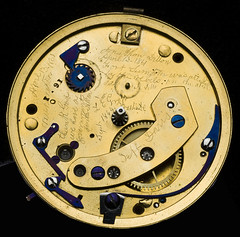 Watchmaker Jonathan Dillon was repairing Lincoln's watch in April 1861 when he heard about the attack on Fort Sumter, South Carolina, and wrote a short message on the metal inside the watch, the Smithsonian said.
Watchmaker Jonathan Dillon was repairing Lincoln's watch in April 1861 when he heard about the attack on Fort Sumter, South Carolina, and wrote a short message on the metal inside the watch, the Smithsonian said.There it remained, unseen for almost 150 years, it said.
In a 1906 interview with The New York Times, Dillon reported that as soon as he heard the news about the first shots of the Civil War, he unscrewed the dial of the watch and wrote on the metal, "The first gun is fired. Slavery is dead. Thank God we have a President who at least will try."
The actual message that the museum found differs from the watchmaker's recollection. It says, "Jonathan Dillon, April 13-1861, Fort Sumpter [sic] was attacked by the rebels on the above date J Dillon, April 13-1861, Washington, thank God we have a government, Jonth Dillon."
To read the complete article, see: War message found inside Lincoln's watch (http://www.cnn.com/2009/US/03/10/lincoln.watch/index.html)
Lincoln himself never knew of the message he carried in his pocket. In fact, museum curators had been unaware of the possibility of any such inscription until Doug Stiles, great-great-grandson of watchmaker Jonathan Dillon, phoned to corroborate a story that had been passed down for generations in the Dillon family.
George Thomas deftly lifted the watch face and peeked inside. He was about to help solve a centuries-old mystery. A smile lit up his face and there was an audible gasp from the room as he motioned for the watchmaker’s great-great-grandsons to come up and read the inscription inside the timepiece aloud. Doug Stiles, visibly moved by the revelation, borrowed Mr. Thomas’s magnifying glasses and took a moment to inspect the inner workings of the watch. After an expectant pause, he gleefully shared the message with the rest of the room.
To read the complete article, see: A secret message inside Lincoln's watch? (http://blog.americanhistory.si.edu/osaycanyousee/2009/03
/a-hush-fell-over-the-room-as-the-watchmaker-halted-his-work
-a-partially-dismantled-pocket-watch-that-once-belonged-to-pres.html)
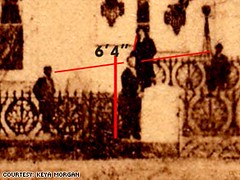 An expert on Lincoln photography thinks a photograph found in Gen. Ulysses S. Grant's family-owned album showing President Abraham Lincoln in front of the White House could be one of the last photos taken of the 16th president before he was assassinated in 1865.
An expert on Lincoln photography thinks a photograph found in Gen. Ulysses S. Grant's family-owned album showing President Abraham Lincoln in front of the White House could be one of the last photos taken of the 16th president before he was assassinated in 1865.Grant's great-great grandson Ulysses S. Grant VI had seen the previously unpublished image in the general's personal photo album, but didn't think much of it until he scrutinized it earlier this year.
"I started to think that it might be the White House," said Grant, a construction business owner from Springfield, Missouri. "Then I started to look at the height difference between the people in the photo."
To read the complete article, see: Photo emerges that might be last taken of Lincoln (http://www.cnn.com/2009/US/03/11/lincoln.photograph/index.html)
MAINE POLICE DEPARTMENT GIVING CHALLENGE COINS TO GOOD CITIZENS
“This is a way to recognize the good deeds that citizens do for each other that go above and beyond the normal courtesies that society expects,” said Saco Police Chief Bradley Paul.
The coins have a picture of the Saco police badge on one side, with the law enforcement oath of honor on the flip side.
“When an officer presents one of these to a citizen, that citizen knows he did something that he should be proud of,” said Paul.
The program was implemented a few weeks ago, said Paul. Recently, an officer gave a coin to a person who contacted police after not hearing or seeing a neighbor for a few days. The individual was concerned that the neighbor, who lived alone, might be ill or need medical attention.
The neighbor was away, and there was no medical emergency, but the person “did the right thing,” by looking out for the neighbor, said Paul.
The coins are a way for the police department to reach out and to establish pride in the community. Many times, police are seen as the people who give out tickets or make arrests, which can have a negative connotation, said Paul.
“We’re always looking for ways to positively impact the community,” said Paul.
To read the complete article, see: Saco to give challenge coins (www.journaltribune.com/pastnews/2009/march2009/NEWS031209.HTML)
FIRM OFFERS FANTASY'S BASED ON SMITHSONIAN'S CHARLES BARBER PUERTO RICO SKETCH
Rafael Valentin forwarded this advertisement for a limited edition of 100 fantasy strikings based on a sketch by Charles Barber for a proposed coin for Puerto Rico. The original sketch is in the holdings of the National Numismatic Collection at the Smithsonian.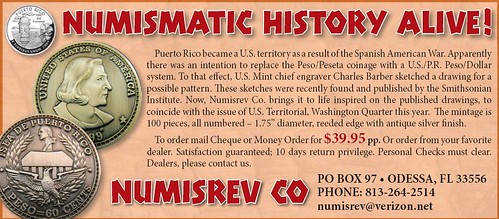
I asked Dick Doty of the NNC about this, and he writes:
Note that the module of the coin would've reflected the absolute value of the silver, rather than the fiduciary value, as seen in the contemporaneous Morgan dollar.
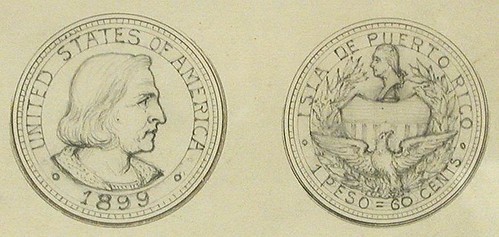
The image of the sketch is taken from the Barber Coins web site: http://www.barbercoins.org/PR-sketch.JPG
COIN COLLECTING AND SNOW DO NOT MIX
He said nothing to any one, but went up to his room and emptied his remaining pockets. He got a shovel and going out to the scene of his mishap, shoveled the snow over the fence into his yard. In a day or two it began to thaw, and for the week following he was picking up copper cents out of his yard. He finally recovered all but one.
A neighbor of mine who was a baker once played a trick upon a creditor of his. He had bought a bill of flour amounting to $2400,00 and when the man came to collect it he told him he would pay it if he would take what coppers he had. He agreed, but was somewhat chagrined when the hired man was called in, and with an iron bar moved out a stout chest full containing 80,000. The story of people paying of large debts in small change appears to be quite old.
IF THAT'S THE QUEEN, THEN I'M KAISER WILHELM
Last week we quoted an article interviewing Adolf Burger, a survivor of the WWII Operation Bernhard Nazi concentration camp counterfeiting scheme known:Tom DeLorey writes:
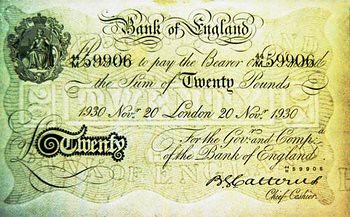
FEATURED WEB PAGE: PUERTO RICO MONETARY HISTORY
This week's Featured Web Page is on the Monetary history of Puerto Rico.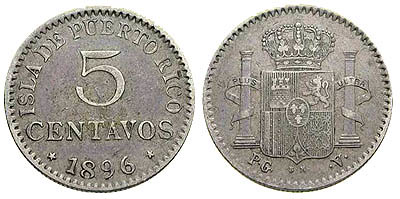
www.topuertorico.org/reference/money.shtml
